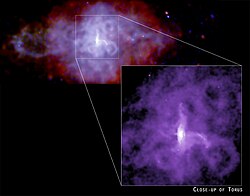3C 58
Appearance
 X-Ray image of 3C58 by Chandra X-Ray Observatory. The pullout box shows the inner toroidal-shaped nebula | |
| Observation data Epoch J2000.0 Equinox J2000.0 | |
|---|---|
| Constellation | Cassiopeia |
| Right ascension | 02h 05m 38s |
| Declination | +64° 49.7′ |
| Apparent magnitude (V) | 8.17 |
| Characteristics | |
| Spectral type | F |
| Astrometry | |
| Distance | 10,000 ly (3067.48 pc) |
| Absolute magnitude (MV) | 3.70 |
| Other designations | |
3C58 or 3C 58 is a pulsar and supernova remnant within the Milky Way that is possibly associated with the supernova SN 1181. There are, however, signs that indicate that it could be several thousand years old, and thus not associated with that supernova.[1]
3C58 is notable for its very high rate of cooling which is unexplained by standard theories of neutron star formation. It is hypothesized that extreme conditions in the star's interior cause a high neutrino flux, which carries away the energy and the star cools.[2]
It is located in the direction of Cassiopeia and is estimated to be 10,000 light-years away.
3C58 has been proposed as a possible quark star.[3][4]
References
- ^ Bietenholz, M. F. (2006-07-01). "Radio Images of 3C 58: Expansion and Motion of Its Wisp". The Astrophysical Journal. 645: 1180–1187. doi:10.1086/504584. ISSN 0004-637X.
- ^ "Chandra :: Photo Album :: 3C58 :: 14 Dec 04". Chandra.harvard.edu. Retrieved 2012-08-21.
- ^ Cramer, John G. (2002-11). "Quark Stars". Analog Science Fiction & Fact Magazine. Retrieved 2015-08-17.
{{cite news}}: Check date values in:|date=(help) - ^ "RX J1856.5-3754 and 3C58 Pulsar". www.solstation.com. Retrieved 2015-08-18.
External links
![]() Media related to 3C 58 at Wikimedia Commons
Media related to 3C 58 at Wikimedia Commons
